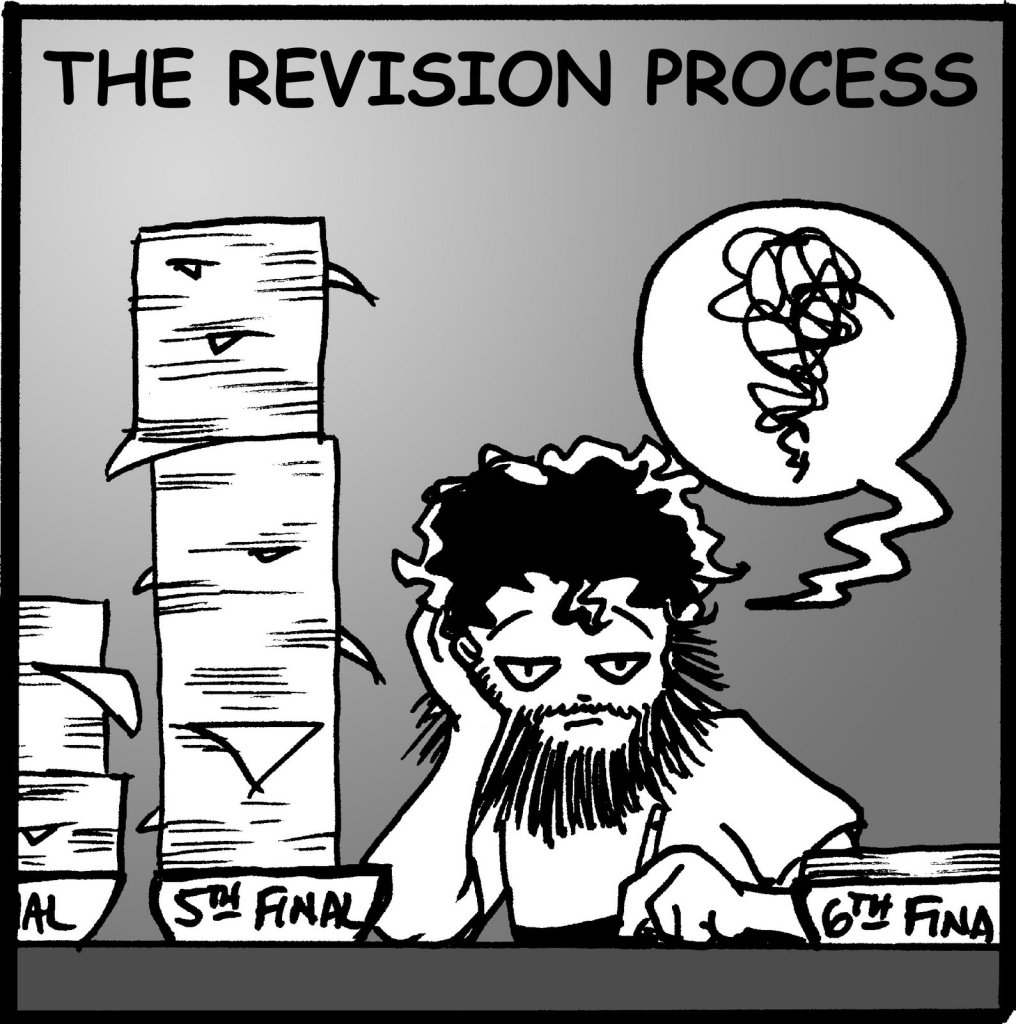How Many Revisions on Projects Do You Offer? Devs and Designers Shared Their Personal Stories [+Survey]
How do you work with project revisions? There's a lot of studios and freelancers who allow a limited number of revisions. Usually, it’s well covered in the contract. But also, some developers and designers don’t limit revisions at all.
The Revision Process according to Patrick Rothfuss
There are different types of clients in any practice. So, this is up to the company/freelancer to decide which way to choose.
I’ve asked different web designers and developers on how they treat revisions requests, and especially how many rounds of revisions do they allow. Let’s discover how they act with meticulous clients, and if they filter or accept new orders from such people/companies.
And, as it’s holiday time, we have one more interesting survey at the end of the article. Keep scrolling to share your vote there.
Cristi Lupchian, Web Developer at Butterfly Media
I strongly think that allowing an unlimited number of revisions is similar to shooting yourself in the leg, plus at the same time, you are making the clients spend time all the time giving them the chance to change today what they changed yesterday.
Having a limited number of revisions makes everything more efficient, the client will focus more as he knows that if he is not making the right changes will have to pay extra and they will give clear instructions in the first place, us as developers we will have all tasks in the same time and not have to do a couples of changes every day - when you have multiple projects that you are working on that can be a productivity killer.
Me personally I am flexible regarding the revisions but I do limit them - that because over the years I learned that if I don't have those in place a project can become a nightmare - although if the revisions are done and the client comes with a last-minute minor change I won't say no, I need to keep my clients happy. Usually, the good clients that are aware that making more changes that they come with a cost, the ones that don't think that needs to be fired, and if I can afford that I do stop working with them, unfortunately sometimes we can't afford that but I do not let them taking advantage of that either.
Craig Murphy, Managing Director at ALT Agency
We split our projects into 2 phases - Design & development. We do purely design JPG work up front before coding in case of revisions.
I've heard of agencies who don't even show designs to clients until all the coding is finished which is a little bit bizarre.
During our design phase we have a thorough project management process which aims to nail down as much as possible in words the design requirements.
From here it's handed to out designer.
Our thorough pre-project management process enables us to get a design 90% right 90% of the time.
We tend to offer a fair 3 revisions to a first draft, these can be minor or complete overhauls and different designs, after that, if we can't get it right within 3 attempts we would give the client their money back - Our pre-project management process aims to avoid this.
Maksym Babych, CEO and Owner of SpdLoad
Talking about development revisions our team provides all of the customers with a guarantee of an unlimited number of bug-fixing in a month after the contract ends.
We do not make any feature changes or massive updates in that month. There are a few reasons why we work this way:
1. To keep relationships with customers equal and transparent.
2. To avoid unnecessary conflicts of interest and any kind of manipulations - on both sides.
3. To make relationships predictable, repeatable and scalable.To follow these points, we build the corresponding negotiations and development processes. To avoid any kind of misunderstand and misexpectations we approve every decision at every stage of development. From idea concept to final version of requirements.
Detailed discussion at every stage and very detailed documentation helps us create a single vision on the project.
In-house testing of the project allows us to deliver a bug-free or minimum-bug project to the customer. So usually, there are no many bugs to fix in guarantee terms.
Nick Leffler, Loclweb
For Loclweb clients we limit revisions to one major review cycle based on the home page and one internal page. While we do write this in our contract for clients, we also guarantee 100% satisfaction so often do not stick to the one revision cycle. We'd rather have a 100% satisfied client than breaking up a business relationship where one party is unhappy.
The only stipulation with the revision cycle is that the time for all revisions are not included in our guaranteed delivery time. We guarantee delivery of websites within one or two weeks (depending on the plan). Because revisions can potentially go on for some time with unresponsive clients or several revisions (not common) our client is delaying the delivery of their website and paying the monthly cost for it if their reviews go on for too long. It's in our client's best interest to be prompt with their reviews in order to get their website released.
All websites designed for Loclweb clients also come with unlimited minor changes so revisions are never 100% complete. That means that there are no limits on revisions except major revisions after the final website is approved and released. Major revisions after initial development are charged but smaller revisions are always included as long as they're a client.
For revisions both minor and major through development and release we're now using WP Feedback which has made tracking and implementing changes a breeze. Clients request modifications on the correct page and in the correct place and we get a task to complete them. Simple!
Stephan Roussan, Founder, and President of ICVM Group
Allowing revisions is really important, not just to get the details right but also to allow the client to participate in the process. Having a hand in the finished product helps to secure buy-in and approval, and the less haggling is required over it the better everyone feels.
But some protection is important. Every once in a while, you'll get a client that will send you in circles for weeks and blow your entire budget before you even get to the build stage. To strike the right balance, we do two things in our agreements:
- First, we do quantify a certain number of revisions for the initial exploration phase and again for the iterative production phase. We often allow it to go over without making a fuss, but it allows us to come back to that point if we need to ("hey, we included 3 rounds and we're now at 8....").
- Second, we include a ceiling on man-hours for the project as a whole. It's a generous cap that shouldn't be hit. But if any particular phase of the project is chewing up gobs of hours, we can relay this to the client and remind them that we still have a ways to go and might go over the cap if we don't move on soon!
Jay Tillery, Remote WordPress/Shopify Developer
I typically do 3 rounds of revisions with a clause in the contract that states any additional revisions after the initial 3 will incur an extra fee. Sometimes the clients will approve after the first or second round. If there is a third round, the revisions are so minimal that it almost never goes past that.
I accept reorders from all of my past clients. Those meticulous ones keep you stressed out yes, but they keep you on your game too. Gotta love them. 🙂
Ihtisham Zahoor, Web Developer at Centangle / Writes at CodexSpot
So, this is how I perceive unlimited revisions... Either I am not capable of delivering what I agreed to or I lack effective communication skills. In any case, it is alarming for the clients or my own professional growth. That being said, I take the projects I fully understand their requirements and are dead sure that I will deliver on time. In any case, depending on the size of the project, I don't exceed 10 revisions.
As far as working for a detailed oriented client is concerned. It is more about their overall behavior and their response after providing them with insights into an issue which they are unaware of before.
Brandon Howard, Owner of All My Web Needs
We used to give people unlimited revisions. Most clients do not meticulously pull apart the website design, but some do. We've learned that it's best to implement a limit of 10 hours for revisions after a website demo is initially sent to the client for review. Although this limit is clearly outlined in our contract, we rarely hold people to it (i.e. if someone hits 12 hours we don't even tell them).
In cases where the client is going overboard with edit requests, we confirm with them at 9 hours that they have an additional hour of revisions allotted and that additional revisions will add cost after that. It seems to work pretty well.
Travis Buck, Vice President at NW Media Collective
As a web developer, I offer unlimited revisions. I’m not talking about a money-back guarantee with no expiration date, but I’ve always built sites knowing that I didn't want my client thinking they were limited to a set number of changes. My goal early on was to make sure that the client liked what they were paying for. If there was a part of the design that wasn’t easy for them to update once I got to development, I would just change that piece of functionality. In those days I knew I was charging a higher rate than most other developers and I wanted that client to be confident that they were receiving a premium product.
No one wants to be stuck doing design revisions forever. I made sure clients were aware that timelines are not set in stone. The Design phase is estimated to take a given number of weeks. However, if we really had unlimited rounds of changes, the site would never launch. That design phase is there to hit the target with the various elements they think a website needs. Sometimes design changes are justified and some are pretty major and will affect other areas of the website, so I think it’s important to help the client understand this.
Design sign-off is a must, and we’re always sure to make this clear. We still make changes until you are happy, but these changes will push the site launch back. The longer a site takes to develop, the less likely it is to launch. Minor changes are fine, but large design changes after sign-off stop the actual code work. That’s when you want to figure out what's out of scope. Once the site is in development it’s really hard to change something without changing the plan for other areas of the site. Clients don’t want to make unending changes and revisions. They want a project that will finish on time and on budget. They also want it to represent their business and their brand; telling them a number of revisions it will take just isn’t something we focus on.
As the company has grown, we’ve started telling clients we will make changes until you’re happy. There are, unofficially, 3 rounds of design changes now. We try to help clients understand that this helps both parties to stay on track with our launch date, ensuring that the project is a success for everyone involved.
Sam Orchard, MD & Creative Manager at Edge of the Web
When it comes to revisions, we don’t have a set number that we allow, but instead we structure our workflow in such a way that organically reduces the number of revisions required.
Firstly, we do a lot of planning and strategy before we start design, including providing interactive wireframes that clients can click through.This gives them the opportunity to use the website and identify any problems in usability, layout or content before we get to the designs themselves.
Once the design is ready, we do a full presentation for the client, going through the decisions we’ve made so they’ve got a real insight into the design.
After the presentation, we encourage the client to take a little time with the design so they’re not making any knee-jerk reactions (whether they’re positive or negative), and also provide them with a sign-off document for when they’re ready to move forward.
By implementing this process we usually get one or two rounds of revisions, but rarely more. The upfront planning and wireframing enables us to iron out most issues before the design phase, and by providing a sign-off document, clients know that they need to be completely happy with their design before moving forward. The nice thing about this process is that we never have to limit clients to a set number of revisions, but at the same time, we don’t get stuck in a loop of endless changes.
Scott Krieger, Creative Director & Web Developer at Studio 64
Setting expectations is key here, otherwise you are giving carte blanche to clients to give you the runaround. Thinking you are at their beck and call for a spelling change!
In the contract we instill a maintenance clause, which allows for 4 hours of edit/manual changes per month, anything over that is charged at an hourly rate.
To mitigate minor quibbles and requests from clients, we ensure that they have ½ a day training with us on how to manage the basics of the websites. This enables them to complete tasks such as - add new blog articles, post promotions, change spelling, add images etc.
Marius Vetrici, WordPress specialist at WPRiders
Most of our projects are related to ecommerge, memberships or LMS platform development. These projects do not include too much design; there’s more technical custom work for specific features.
Here, the initial Scope of Work - SOW is the key: the clearer the initial SOW, the fewer discussions will be down the road.
So, we start by writing a good SOW and we usually charge for this consultation service.
Next, once the SOW has been confirmed, and the estimate accepted, we to work on the project.
When the project is delivered, it has to match the SOW. If it doesn’t match, then we go into revisions. In the end, the client should receive what he has agreed for in the SOW.
Now with this approach in mind, it moves the accountability from the client to us and pushes us to be very thorough with testing so as to have as few revisions as possible 🙂
The other thing we are doing is we are agreeing a timeline with the client and we set specific dates by which we should deliver and by which he/she should provide the feedback. In our contracts we write that if the projects will pass the agreed upon feedback date, we will switch to hourly billing, we have never had to resort to that clause because clients are eager to get their platform or plugin up and running and they are providing the feedback in due time.
Ryan Gittings, Freelance Web Designer
Generally I have 3 revisions as part of my standard contract. Clients have the option to pay for further revisions at an additional cost.
Nicole Pereira, Marketing Automation Consultant at Chief Martech Officer
Since we are hourly we have unlimited revisions! But, we do try and encourage our clients to launch the website and continue to iterate afterwards.
Jason Vickers, President at UNIFY marketing & technology solutions
We typically do not put revision limits in place for our web design services as I want the client to be enthusiastic enough about the final website design to tell others about our services and I think the best way to do that is to give them exactly what they want out of a website. I do understand how unlimited revisions can put a strain on a smaller agency or freelancer though so my advice to avoid running into this problem would be to:
1. Carefully choose the clients that you feel are best for you, don’t be afraid to pass on a project.
2. Secure 50% of the project cost upfront
3. Clearly define the scope of the project
If I worked with a customer before and know that they will require many revisions, I would rather build the extra cost into the new proposal versus limiting the amount of revisions as I always want to end with a client that is enthusiastic enough to refer us to others.
And here's the bonus! It’s the end of the year and time for stocktaking. Let’s find out how many of us try to sort things out before the Christmas and New Year celebrations begin.
As for me, I'll try to finalize everything before the holidays start. What about you? Let’s see how many of us consider holidays while planning project deadlines, and how many don’t.
Maksym Babych, CEO and Owner of SpdLoad
Marius Vetrici, WordPress specialist at WPRiders
Scott Krieger, Creative Director & Web Developer at Studio 64
Sam Orchard, MD & Creative Manager at Edge of the Web
Travis Buck, Vice President at NW Media Collective
Brandon Howard, Owner of All My Web Needs
Jay Tillery, Remote WordPress/Shopify Developer
Nick Leffler, Loclweb
Jason Vickers, President at UNIFY marketing & technology solutions
Get more to your email
Subscribe to our newsletter and access exclusive content and offers available only to MonsterPost subscribers.


















Leave a Reply
You must be logged in to post a comment.